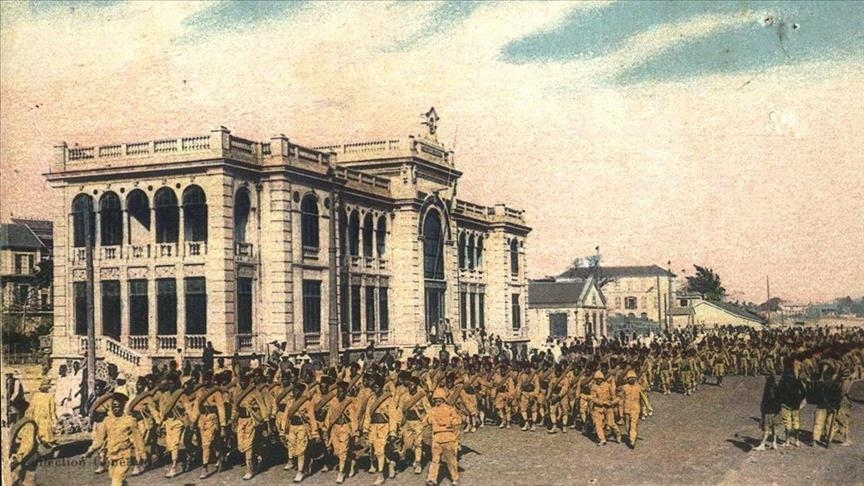France's long-forgotten heroes: Senegalese riflemen
At least 60,000 African soldiers fought, died for France during world wars

DAKAR, Senegal
The tragic story of "Senegalese Tirailleurs," the African infantrymen who were dragged to combat by force along with French troops during the two world wars, are still in memory after more than a century.
Father & Soldier (Tirailleurs), a movie starring Omar Sy, a French actor of Senegalese descent, put the light on what France did to the African soldiers during the colonial era.
It tells the story of a Senegalese father, Bakary Diallo, who went to the fronts to save his 17-year-old son deployed by force in the French army in 1917.
The movie triggered a debate about the law of war, racism and colonialism, and the Senegalese riflemen issue – which is a festering sore for African people – gained international recognition thanks to world-famous actor Omar Sy, who played Bakary Diallo.
Soldiers coming from sub-Saharan Africa under the French colony were the members of the colonial infantry battalion created by Napoleon III in 1857.
Most of its soldiers were Senegalese, so Senegalese Tirailleurs were named after them – but the battalion also gathered soldiers from Benin, Ivory Coast, Guinea, Mali, Burkina Faso, Niger, and Mauritania, the countries that were former colonies of France.
The Senegalese riflemen had been deployed in many combats during the world wars, including the Battle of Verdun in France and the Battle of Canakkale in Türkiye, until no less than 17 African countries gained their independence in 1960.
They also played a major part in French history during the wars in Indochina, Algeria, and Madagascar.
Some 200,000 Senegalese riflemen were deployed during World War l and 140,000 others during World War ll. At least 60,000 of them were killed in total.
1st Black French MP persuade the Africans against riot
Suffering from demographic disadvantages against Germany when World War l broke out, France wanted to fill the gap with the Senegalese riflemen.
Paris wanted to deploy young soldiers from Sub-Saharan Africa but faced popular resistance.
French authorities made a pact with Blaise Diagne, the first Black member of the French parliament, to have him prevented possible rebellions.
Diagne, appointed as commissioner in charge of recruiting new soldiers, traveled from Dakar, Senegal to Bamako, Mali.
The Africans living in the French colonies had no rights at all, which made things easier for Diagne. He said those going to the fronts would have many rights when they came back, including citizenship.
This is how Diagne persuaded opinion leaders and religious leaders.
The Tijaniyyah order's leader El Hadj Malick Sy agreed to send his elder son Sidy Ahmet Sy, like many others, to the front.
Sy's son turned out to be killed in Thessaloniki at the early stages of World War l.
Some of the African soldiers, whose uniforms, camps, and even food rations were different from those of their French peers, died of cold weather conditions unknown to them and contagious diseases.
In early 1916, African soldiers were placed in a special military post named Corneau in southwestern France so that they got used to winter.
Corneau, built in a damp and marshy area, caused deadly respiratory infections among the African soldiers. Many of them died soon because of pneumonia and Corneau was known as the "barracks of misery."
Instead of evacuating the camp, French authorities experimented on soldiers the vaccines developed by the Defense Ministry and Pasteur Institute.
In one and a half years, 958 soldiers died in this camp accommodating 27,000 soldiers in 600 sheds.
Dead bodies were thrown into mass graves, they were never identified, and their families never learned the truth.
Director Serge Simon filmed a documentary titled Une pensee du Courneau in 2011 about the camp.
Fought for France, massacred by France
Senegalese riflemen were also massacred by France.
Held captive by Germans during World War II and liberated by the Americans in 1944, those African soldiers were brought to the Thiaroye camp near Dakar.
They wanted to return their home after getting their bonuses and indemnities but the French officials refused to pay them as they had promised.
The African soldiers gathered to claim their rights and the French soldiers executed 35 of them on the pretext that they were revolting, as the French archives suggest.
According to French historian Armelle Mabon, 400 African soldiers were killed that day.
Their bodies were thrown into mass graves but a symbolic cemetery was built in the Thiaroye camp.
During a visit in 2014, former French President Francois Hollande described those incidents as "terrifying and unbearable."
"I want to fix this injustice," Hollande said, but the families of the executed soldiers are still waiting for indemnity and apology after 79 years.
Senegalese riflemen are commemorated on Dec. 1 every year since 2004, the day of the massacre.
*Writing by Nur Asena Erturk in Ankara
Anadolu Agency website contains only a portion of the news stories offered to subscribers in the AA News Broadcasting System (HAS), and in summarized form. Please contact us for subscription options.







